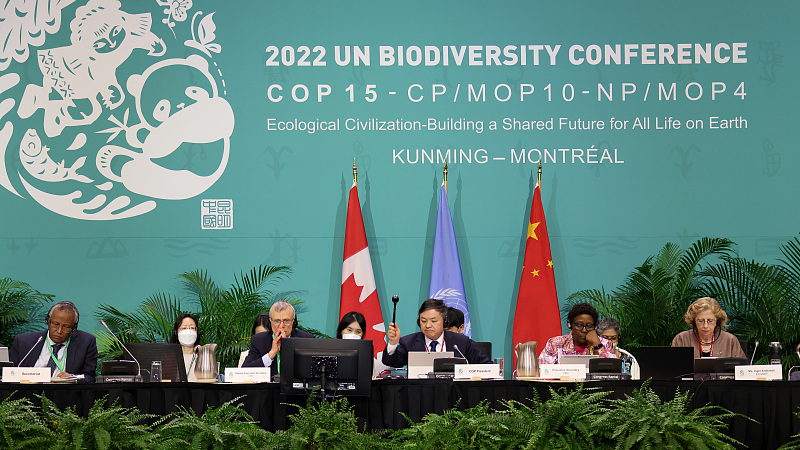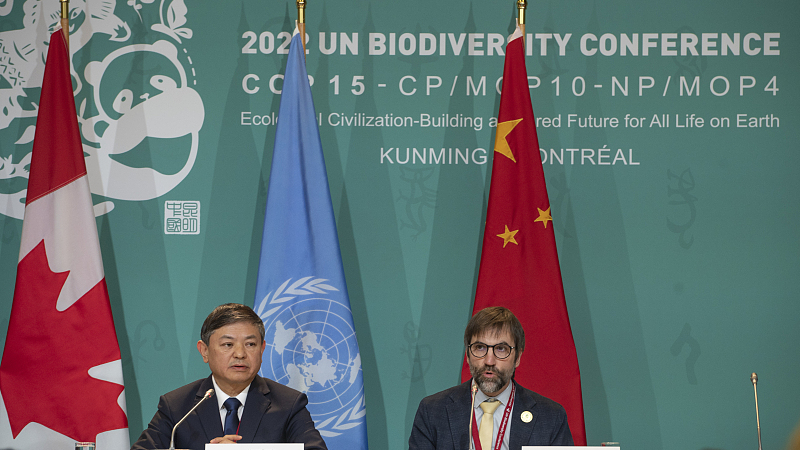
Kunming-Montreal Global Biodiversity Framework was adopted at the COP15, Montreal, Canada, December 19, 2022. /CFP
Kunming-Montreal Global Biodiversity Framework was adopted at the COP15, Montreal, Canada, December 19, 2022. /CFP
Editor's note: Azhar Azam works in a private organization as a market and business analyst and writes about geopolitical issues and regional conflicts. The article reflects the author's opinions and not necessarily those of CGTN.
Biodiversity is the variability among living organisms from all sources and includes diversity within and between species and of ecosystems. It encompasses millions of distinct species, crops varieties and several types of marine and terrestrial ecosystems in which humans live and depend on, such as coastal areas, forests, wetlands, grasslands, mountains and deserts. It's essential for sustainable development and processes that help life organisms to survive on earth.
At the close of the second phase of the 15th meeting of the Conference of the Parties to the UN Convention on Biological Diversity (COP15) in Montreal, Canada, delegates adopted the highly-anticipated Kunming-Montreal Global Diversity Framework. The agreement following two weeks of Beijing's efforts to negotiate a deal among 196 parties under its presidency to restore biodiversity loss.
China has built a global consensus on biodiversity protection. At the first phase of the COP15 in Kunming, Beijing blazed a trail by calling on all parties to demonstrate flexibility, continue on with momentum to fulfill commitments of the Kunming Declaration and prepare for the adoption of an ambitious biodiversity framework. In Montreal, it came to fruition and that would be consequential to achieve global biodiversity targets.
Beijing's fundamental role, as well as attempts to engage parties and organize bilateral and multilateral events and discussions to clinch a compromise recently drawing praise from Elizabeth Maruma Mrema, Executive Secretary of the UN Convention on Biological Diversity (CBD) and Marco Lambertini, Director General of the World Wildlife Fund International.
According to the CBD, China is among the world's 12 mega biodiverse countries. Alongside forest cover of 22.96 percent of the total land area and perhaps the largest stock volume of forest plantations, it harbors abundant and diverse wildlife. China is also one of the eight centers of origin for crops with about 10,000 species of crops and their relatives and rich in marsh, lake and river wetlands. Grasslands cover about 41.7 percent. Marine areas shelter some 20, 278 species (10 percent of world). Deserts account for 27.46 percent.

Huang Runqiu (L), president of the COP15 and minister of Ecology and Environment of China, listens as Steven Guilbeault, minister of Environment and Climate Change of Canada, addresses a press conference at the COP15, Montreal, Canada, December 17, 2022. /CFP
Huang Runqiu (L), president of the COP15 and minister of Ecology and Environment of China, listens as Steven Guilbeault, minister of Environment and Climate Change of Canada, addresses a press conference at the COP15, Montreal, Canada, December 17, 2022. /CFP
Just months after the CBD entered into effect on December 29, 1993, laying out three main objectives – conservation of biodiversity, sustainable use of components of biodiversity and fair and equitable sharing of benefits from genetic resource utilization – the Chinese State Council in June 1994 released the Biodiversity Conservation Action Plan to take effective measures to prevent biodiversity losses by reducing the rate of biodiversity loss.
At around the release of China's National Biodiversity Strategy and Action Plan (2011-2030) to implement the provisions of the CBD and strengthen the biodiversity in the country, seven goals of the prior strategy had been mostly achieved and most of 26 priority actions were implemented. "The implementation of the Action Plan has strongly promoted biodiversity conservation in China," said the CBD report.
The successive plan enshrining principles – such as conservation, sustainable use, public participation and benefit-sharing – has gotten implemented, while offering guidance on 10 priority areas including policy and legal framework for biodiversity conservation and sustainable utilization of bio-resources and 30 actions including inter-departmental coordination mechanism.
The Chinese Ministry of Environmental Protection had teamed up with more than 20 ministries and departments to update the new strategy. Regarding the 2020 global biodiversity (the Aichi) targets, Beijing has contributed to the UN Sustainable Development Goals and 2020 global biodiversity targets by fulfilling its obligations and advancing 13 targets, even exceeding three others: establishing terrestrial nature reserves, restoring ecosystem services and elevating ecosystem resilience and carbon storage.
The country's proposal, drawing a "red line" for ecological protection to mitigate and adapt to climate change, was selected by the UN as one of 15 best nature-based solutions the world over. In a bid to further conserve biodiversity, China has designated 25 percent of its land as ecological conservation and would push forward on the global process of biodiversity protection.
During the gathering, countries pledged to revive one billion hectares of land and coasts, an area larger than China. The UN recently evaluated and recognized 10 groundbreaking initiatives, the World Restoration Flagships, from around the planet that could restore more than 68 million hectares, and generate almost 15 million jobs.
Nonetheless, a smear campaign is underway to dampen China's contributions to biodiversity conservation by accusing it of illegal fishing and trivializing Chinese actions over protecting wildlife. But such efforts will not gather steam, since the CBD acknowledges China has introduced a fishing licensing system and fishing ban season, enacted considerable policy measures for the use of wildlife resources such as a 10-year prohibition in the Yangtze River and conducted special campaigns against illegal fishing.
China has acted in a phenomenal manner and continues to demonstrate leadership not just in global biodiversity protection but has inspired the world to converge on common interests and to tackle shared challenges.
The adoption of the Kunming-Montreal Global Biodiversity Framework, an indivisible (and) ambitious package and a crucial deal named after the two host cities of China and Canada, is a tremendous achievement that exemplifies engagement and dialogue is a key to resolve differences to counter global threats and Beijing remains a vital global player to tackle all issues and build universal consensus.
(If you want to contribute and have specific expertise, please contact us at opinions@cgtn.com. Follow @thouse_opinionson Twitter to discover the latest commentaries on CGTN Opinion Section.)